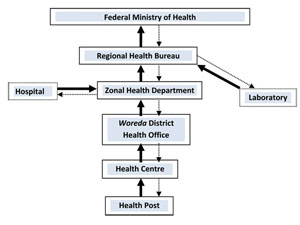Passive surveillance
Passive surveillance refers to the collection of data by health facilities as part of their routine work of diagnosis and treatment (Figure 40.4). It is called 'passive' because the data is obtained only from the people who seek help from the health services – the health workers make no additional effort to contact other individuals. In Ethiopia, there is a passive surveillance system based on monthly activity reports and weekly reporting of notifiable diseases, i.e. diseases that must be reported to the health authorities. Most communicable disease outbreaks should be reported by telephone or radio to your Health Centre (as you will learn in Study Session 41).

Figure 40.5 shows the flow of passive surveillance information in Ethiopia. Under this system, your Health Post and other facilities are required by the Federal Ministry of Health (FMOH) to report all collected data about diseases in your community on a regular basis. The reports are made routinely at agreed intervals (e.g. every month) without being requested. As the solid arrows in Figure 40.5 indicate, Health Posts report surveillance data to Health Centres, the Health Centres report data to the woreda District Health Offices, and so on until the information reaches the FMOH, the highest level. The broken arrows show that exchange of information also occurs in the opposite direction.

What do you think is the importance of the solid arrow from the Laboratory to the Regional Health Bureau (RHB) in Figure 40.5?
Laboratory confirmation of a clinical diagnosis is important in providing accurate data on confirmed cases of communicable diseases in the community.
Passive surveillance is cheap to operate, because it takes place as part of routine health-service work, and it helps you and the higher authorities to monitor the occurrence of many diseases and other health problems. However, it has some disadvantages. The surveillance reports may take a long time to reach the highest level, and some key information may be lacking (e.g. if the health worker forgets to collect data on a statistic such as the sex or age of some patients).
What gaps could there be in the data on diseases/disorders in a community if the data are only collected through passive surveillance?
Passive surveillance misses all the cases out in the community in people who haven't sought help from the health services. This gap is a particular concern in remote areas, where people may not be able to access health services easily.